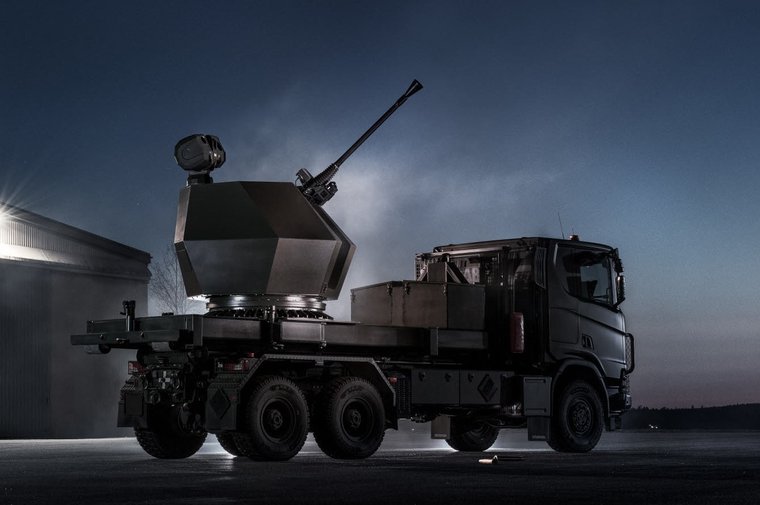BAE Systems shows Bofors 40mm naval gun as Tridon Mk2 land air defence system
Details
More Products & Services
Products & Services
Defence Insight
Shephard Media
Some of the things people like you use Defence Insight for:
- Total addressable market sizing ($)
- Competitor analysis
- Cost analysis
- Market forecasting
- Growth identification
- Increasing closing ratio
- Increasing closing order value
- Estimating product potential
- Calculating sales forecasting
- Supply and demand analysis
- Total addressable market sizing ($)
- Competitor analysis
- Cost analysis
- Market forecasting
- Growth identification
- Increasing closing ratio
- Increasing closing order value
- Estimating product potential
- Calculating sales forecasting
- Supply and demand analysis
Shephard Plus Update
Shephard Media
Shephard Plus is updating in June 2018 with rich new capabilities, and is now one of the most cost-effective and valuable aerospace and defence market intell...
Military Unmanned Systems Handbook
Shephard Media
The Military Unmanned Systems Handbook (Digital Download) is an international guide to the military UV industry and provides detailed information on air, ground and sea (surface & sub-sea) vehicles as well as subsystems. What's included: Unencrypted 390+ page PDF of equipment and supplier information Market summary
Description
BAE Systems will unveil an improved version of its Tridon anti-aircraft system at Eurosatory 2024. The system will feature an improved focus on CUAS capability and enable the use of Bofors 3P (Pre-fragmented, Programmable, Proximity fused) programmable all-target ammunition.
Like the first version, the Tridon Mk2 will be built on the Bofors 40mm naval gun and has been designed to be relatively vehicle agnostic or deployable. Each Tridon Mk2 will have its own all-weather, day-night acquisition sensors built around a development of the Chess Dynamics Hawkeye EO system and fire-control system.
Shephard reported a model of the system was on display at DSEI 2023 and marketed for land applications under the name Bofors 40mm Mk4 L. At the time, it was noted that the L-model would typically be installed on the rear of an 8x8 high mobility platform such as the Rheinmetall MAN HX, which was selected for the latest version of the Archer 155mm self-propelled artillery system to be adopted by the Swedish Army.
Related Articles
Bofors guns arm Belgian-Dutch MCMVs
DSEI 2023: BAE outlines land-based roles for Bofors 40mm naval gun
The current system has been test-fired from a civilian truck and most recently from a Scania G460 military truck. It could be used from most 6x6 or 8x8 vehicles, as well as the BVS10, according to BAE Systems.
Stefan Löfström, director of marketing and sales for BAE Systems Bofors, said the company foresaw the need for CUAS systems prior to the Russia-Ukraine war, during which the accelerated capability and development work on UAS systems has been heavily highlighted.
“This is a proven gun with range of more than 12.5km and it can engage [a range of targets from] high-speed supersonic missiles and fighter aircraft, to small UAS and ground targets such as IFVs at 300 rd/min,” Löfström said.
“We have taken the mature technology of the 40mm Mk4 naval gun with more than 60 units sold and 3P ammunition, and integrated it with a fire director,” he added. “We have integrated it with the Giraffe GX1 air defence radar with the radar positioned 100m from the vehicle.”
The Tridon Mk2 uses a Chess Dynamics Hawkeye sensor. (Photo: BAE Systems)
The company said it was confident Tridon Mk2 could be successfully integrated with a range of vehicles and was working towards creating a supply chain that would allow systems to be delivered within 15 months of orders.
In terms of vehicles, BAE Systems noted there would be challenges to overcome such as requiring outriggers to stabilise a platform the size of the BVS10 should a Tridon Mk2 system be integrated onto it.
The system features an electric drive rather than a hydraulic drive meaning the drive can be tweaked and its performance tuned to match integration with specific vehicles. The rate of fire can be controlled to meet the requirements of vehicles such as modifying the maximum rate of fire to 200 rd/min rather than 300 rd/min.
Löfström said the company had used its Grindstone simulation software to support the trials and evaluate targets.
“Development started in September 2023 and we performed the first firings from a civilian truck in mid-February 2024,” Löfström explained. “We didn't get the Scania truck until April and we decided to do as few modifications as possible, only strengthening the roof of the cabin and lowering the [height of the gun] to meet traffic regulations in Sweden.
The Tridon Mk2 can be integrated with different vehicles. (Photo: BAE Systems)
“Also, we are [looking] to fire armour-piercing fin-stabilised discarding sabot (APFSDS) and right now can use five different kinds of ammunition but can include others,” he noted.
The six-mode programmable 3P ammunition operates in proximity, impact and timed modes. It has been used with naval weapons and can be programmed in six different function modes to provide optimised effect against aerial, surface or shore targets.
The six modes are gated proximity mode (air defence), gated proximity mode with impact priority (air defence, large targets), time mode (small fast, manoeuvring surface targets and concealed onshore targets), impact mode (surface targets), armour piercing mode (armoured surface targets) and proximity mode (default mode).
Shephard's Eurosatory 2024 coverage is sponsored by:
Like the first version, the Tridon Mk2 will be built on the Bofors 40mm naval gun and has been designed to be relatively vehicle agnostic or deployable. Each Tridon Mk2 will have its own all-weather, day-night acquisition sensors built around a development of the Chess Dynamics Hawkeye EO system and fire-control system.
Shephard reported a model of the system was on display at DSEI 2023 and marketed for land applications under the name Bofors 40mm Mk4 L. At the time, it was noted that the L-model would typically be installed on the rear of an 8x8 high mobility platform such as the Rheinmetall MAN HX, which was selected for the latest version of the Archer 155mm self-propelled artillery system to be adopted by the Swedish Army.
Related Articles
Bofors guns arm Belgian-Dutch MCMVs
DSEI 2023: BAE outlines land-based roles for Bofors 40mm naval gun
The current system has been test-fired from a civilian truck and most recently from a Scania G460 military truck. It could be used from most 6x6 or 8x8 vehicles, as well as the BVS10, according to BAE Systems.
Stefan Löfström, director of marketing and sales for BAE Systems Bofors, said the company foresaw the need for CUAS systems prior to the Russia-Ukraine war, during which the accelerated capability and development work on UAS systems has been heavily highlighted.
“This is a proven gun with range of more than 12.5km and it can engage [a range of targets from] high-speed supersonic missiles and fighter aircraft, to small UAS and ground targets such as IFVs at 300 rd/min,” Löfström said.
“We have taken the mature technology of the 40mm Mk4 naval gun with more than 60 units sold and 3P ammunition, and integrated it with a fire director,” he added. “We have integrated it with the Giraffe GX1 air defence radar with the radar positioned 100m from the vehicle.”
The Tridon Mk2 uses a Chess Dynamics Hawkeye sensor. (Photo: BAE Systems)
The company said it was confident Tridon Mk2 could be successfully integrated with a range of vehicles and was working towards creating a supply chain that would allow systems to be delivered within 15 months of orders.
In terms of vehicles, BAE Systems noted there would be challenges to overcome such as requiring outriggers to stabilise a platform the size of the BVS10 should a Tridon Mk2 system be integrated onto it.
The system features an electric drive rather than a hydraulic drive meaning the drive can be tweaked and its performance tuned to match integration with specific vehicles. The rate of fire can be controlled to meet the requirements of vehicles such as modifying the maximum rate of fire to 200 rd/min rather than 300 rd/min.
Löfström said the company had used its Grindstone simulation software to support the trials and evaluate targets.
“Development started in September 2023 and we performed the first firings from a civilian truck in mid-February 2024,” Löfström explained. “We didn't get the Scania truck until April and we decided to do as few modifications as possible, only strengthening the roof of the cabin and lowering the [height of the gun] to meet traffic regulations in Sweden.
The Tridon Mk2 can be integrated with different vehicles. (Photo: BAE Systems)
“Also, we are [looking] to fire armour-piercing fin-stabilised discarding sabot (APFSDS) and right now can use five different kinds of ammunition but can include others,” he noted.
The six-mode programmable 3P ammunition operates in proximity, impact and timed modes. It has been used with naval weapons and can be programmed in six different function modes to provide optimised effect against aerial, surface or shore targets.
The six modes are gated proximity mode (air defence), gated proximity mode with impact priority (air defence, large targets), time mode (small fast, manoeuvring surface targets and concealed onshore targets), impact mode (surface targets), armour piercing mode (armoured surface targets) and proximity mode (default mode).
Shephard's Eurosatory 2024 coverage is sponsored by:

Share
Recent Chats
Share via email
Future: handle WhatsApp here
Future: handle LinkedIn here
Future: handle Twitter here
SUBMENU HERE
Share via Chat
Copy Link



